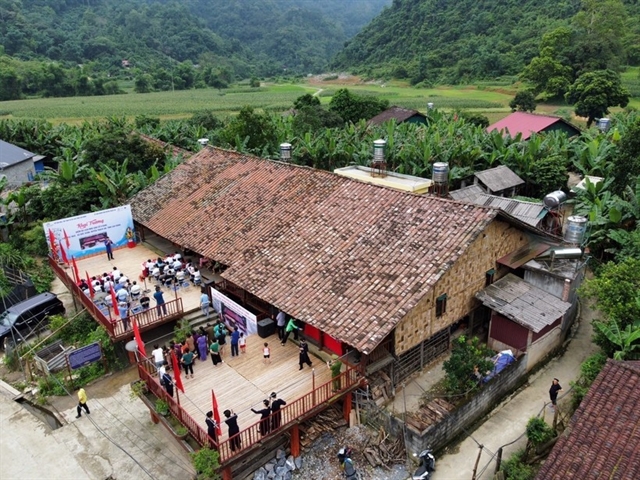 Life & Style
Life & Style

By Lê Việt Dũng
While wooden stilt houses are the norm for the Tày ethnic minority in Việt Nam, the village of Khuổi Ky in Cao Bằng Province stands apart with its unique stone stilt houses, each a silent guardian imbued with a rich defensive history.
According to the elders of Khuổi Ky in Đàm Thủy Commune, Trùng Khánh District, the Tày place great importance on house construction. They have an ancient proverb that says, "A good house site brings peace of mind," reflecting their belief that the location of a house can influence their wellbeing.
Traditional Tày stilt houses are typically built with hard wood timber and have three main rooms with a depth of about five to seven rows of pillars. Wealthier families may build more rooms, but the number of rooms is always odd, as they believe even numbers are for the dead.
The stairs usually have seven to nine steps, symbolising the number of souls of a human being. The roofs are thatched with cogongrass, palm leaves, or terracotta tiles. The walls are made of bamboo or wooden planks. The houses are usually built against the mountains, facing the fields, and running along the hillsides.
Around the 16th century, when the Mạc dynasty lost the capital city of Thăng Long and had to flee to Cao Bằng, the Mạc kings ordered Tày tribe chieftains in border regions, including Khuổi Ky, to build defensive villages to fight against bandits. The villagers had to build stone houses and stone walls as "fortresses" capable of withstanding attacks.
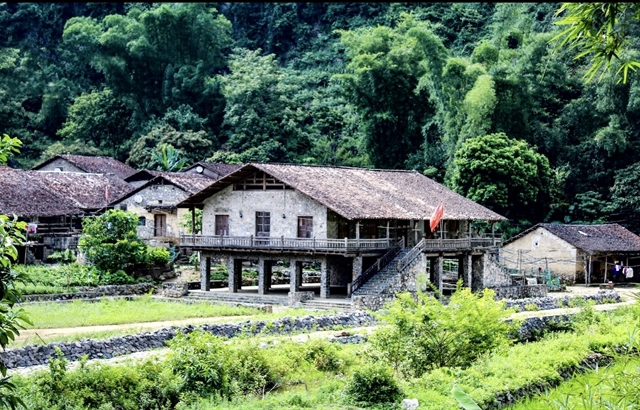 |
| A stone stilt house in Khuổi Ky. Photo baodantoc.vn |
"In the past, border regions were often plagued by bandits, so Tày villages had to be built as a defensive work to ward off raiders," said Nông Ích Nóng, an elder of Khuổi Ky.
The stone walls are built of stone, four to five metres high and up to three metres thick, surrounding the village like a citadel wall. The wall has only one gate on the south side, which usually has three layers of bamboo and wood.
Each property consists of the main house and ancillary structures such as a barn, a storage area, and a corridor connecting the main house to the ancillary structures. Its walls are about 30cm thick and built of stone, sand, and lime, sometimes with molasses and clay. There are loopholes in the walls that allow the owner to observe and shoot out in case of need. The main house is divided into several rooms, each with a door and a loophole. If the defensive corridor is overrun, the owner can retreat to the rooms to continue fighting.
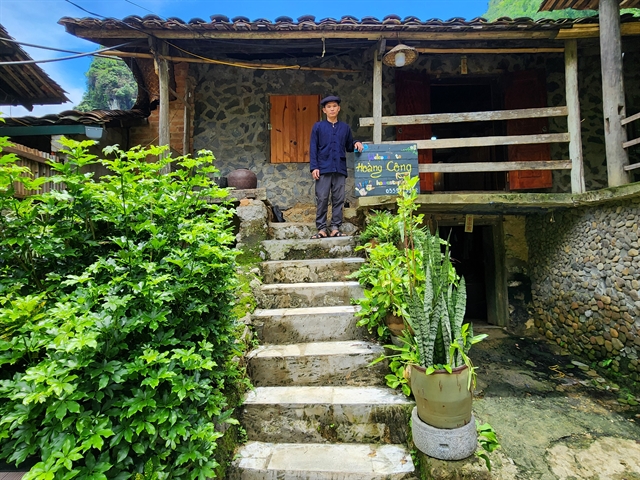 |
| Another stone stilt house offering homestay service in Khuổi Ky. — VNS Photo Lê Việt Dũng |
Building a stone house requires significant effort. The preparation of materials alone can take several years. The stones used are usually hard stones of blue or white colour. The roofs are tiled with curved terracotta tiles made of baked clay for durability and heat resistance.
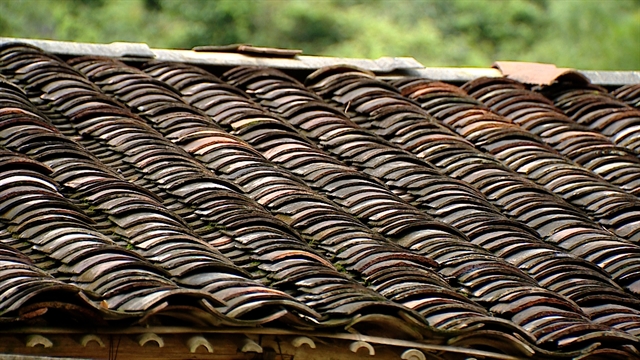 |
| The curved terracotta tiles on the roof of a house. — VNS Photo Lê Việt Dũng |
"It normally takes two to three years to build a house. The most difficult part is stacking the stones to ensure the walls are of even thickness," said Nóng. "Even a small mistake can force the mason to start over."
The choice of stone has spiritual significance, as the Tày in Khuổi Ky revere stone as the source of life and the centre of the universe. They also believe humans originate from and return to stone after death. Every year they hold ceremonies to express gratitude to the stone gods and the mountain gods for their blessings.
Beyond houses, stones are used to build other structures that enhance their daily lives, such as water dams, grinding mills, and ovens. Stone dog statues hold a significant position in the Tày's belief system. These statues are placed at the entrance of homes, serving as symbolic guardians against evil spirits and misfortune.
After building a new house, the homeowner visits a sorcerer to order a stone dog. When a good day is chosen, the sorcerer goes to the mountainside to find a rock to carve a dog statue. Depending on the homeowner's birth year and his house's direction, the sorcerer decides how heavy the dog statue should be, and whether it be lying or sitting.
During significant occasions like the first and fifteenth days of the lunar month, the homeowner offers incense, salt, and rice to the dog statue as a gesture of gratitude for its service in guarding the house. At the turn of the new year, he also prepares a mixture of boiling water and grapefruit leaves to bathe the dog. This ritual symbolises the washing away of past misfortune and the welcoming of future prosperity.
The Tày also hold a house-warming ceremony. When the house is finished, the homeowner piles firewood in the kitchen and chooses four people of good character, each holding a torch, to move from the four corners of the house and light the firewood. They chant the wish for the house to be as strong as a stone mountain. The fire is burned for three days to warm the house and ward off bad luck.
The homeowner then invites the sorcerer to set up an altar. He prays to ask the gods and the homeowner's ancestors to bless his family and use amulets to ward off evil spirits. Ultimately, the homeowner prepares a feast to invite everyone in the village to join in the celebration of the new house.
As wars and banditry seem to be a thing of the past, many ancient stone houses in Khuổi Ky no longer retain their original defensive role.
The high stone wall around the village disappeared, replaced by lower stone walls surrounding each house and serving more of an aesthetic than a defensive purpose. The loopholes have been sealed up, and the interior structure of the houses has been modified to create a more comfortable living space.
 |
| A stone wall around a house, serving more of an aesthetic than a defensive purpose. — VNS Photo Lê Việt Dũng |
The Tày in Khuổi Ky still uphold the tradition of building stone houses, but functionality has taken precedence over fortification. The houses are now designed to accommodate the needs of community-based tourism.
Since Khuổi Ky was recognised as an 'Outstanding Traditional Village of Ethnic Minorities' by the Ministry of Culture, Sports and Tourism in 2008, local authorities have launched initiatives, including tourism training courses and affordable loans, to enable villagers to transform their homes into welcoming homestays.
Khuổi Ky has 17 homestays allowing visitors to stay and immerse themselves in the local residents' daily activities, such as harvesting rice, fishing, enjoying Then songs, and experiencing the local cuisine. They can also go hiking and trekking to admire the majestic mountain scenery.
Mạc Thị Khon, owner of Quang Thuận Homestay, remembers the challenges of relying solely on agriculture for income. Community-based tourism has transformed her life, allowing her to save up money and revamp her house. Beyond her homestay, Khon passionately preserves the Tày's ancient craft of straw-chair and bamboo-basket making. These skills supplement her income and serve as a bridge for visitors to connect with Tày culture.
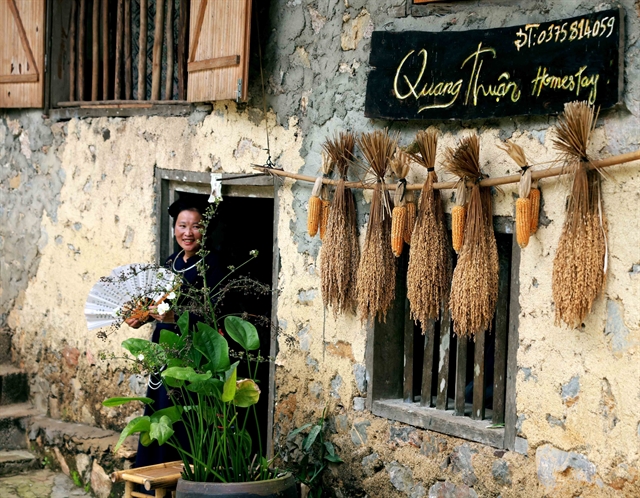 |
| Mạc Thị Khon standing in front of her homestay. — VNA/VNS Photo Phan Nhật Anh |
"I earn more than VNĐ200 million (US$7,880) from homestay business annually," said Khon.
Tày's Homestay, owned by Nguyễn Thị Kim Phương, has created jobs for extra staff during peak tourist seasons.
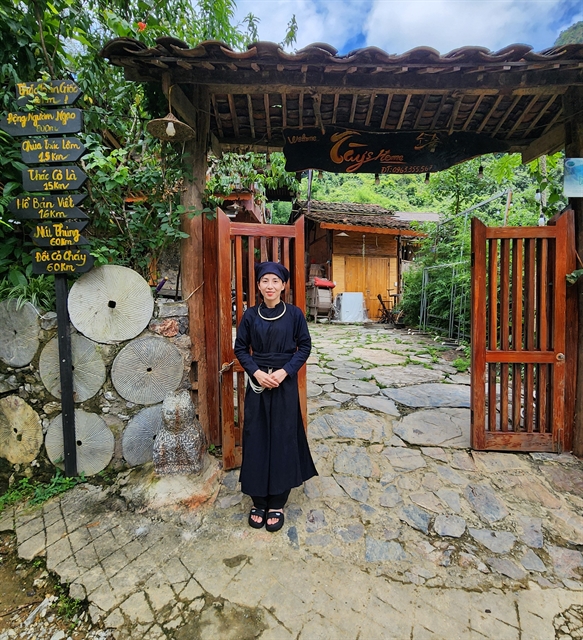 |
| Nguyễn Thị Kim Phương standing at the entrance of her homestay, with a stone dog statue to her right — VNS Photo Lê Việt Dũng |
French tourist Redouane Mahi travelled to Khuổi Ky by bus from Hà Nội. He planned to spend three weeks exploring northern Việt Nam, including Bản Giốc Waterfalls. The village's proximity to Bản Giốc made it the ideal home base for his trip.
"Everything here is fantastic," Mahi said, praising the delicious food, hospitable locals eager to offer travel advice, and the village's atmosphere.
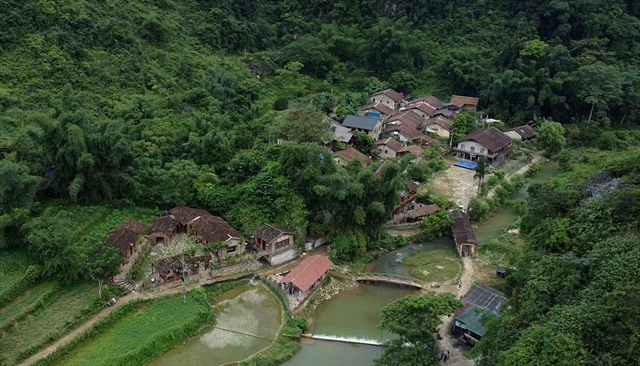 |
| A view of Khuổi Ky from above. — VNS Photo Lê Việt Dũng |
With over 5,000 visitors to Khuổi Ky in 2023, tourism has blossomed into a significant source of income. This economic boost not only uplifts the villagers' lives, but also fuels the preservation of unique Tày stone stilt houses for future generations. VNS




